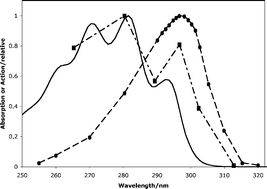Is the action spectrum for the UV-induced production of previtamin D3 in human skin correct?
Abstract
The universally recognised

* Corresponding authors
a
Biomedical Sciences, University of Edinburgh Medical School, Teviot Place, Edinburgh, UK
E-mail:
M.Norval@ed.ac.uk
Tel: +44 131 650 3167
b Department of Cell and Organism Biology, Lund University, Lund, Sweden
c Key Laboratory of Ecology and Environmental Science in Guangdong Higher Education, School of Life Science, South China Normal University, Guangzhou, China
d Department of Dermatology, Leiden University Medical Centre, Leiden, The Netherlands
The universally recognised

 Please wait while we load your content...
Something went wrong. Try again?
Please wait while we load your content...
Something went wrong. Try again?
M. Norval, L. O. Björn and F. R. de Gruijl, Photochem. Photobiol. Sci., 2010, 9, 11 DOI: 10.1039/B9PP00012G
To request permission to reproduce material from this article, please go to the Copyright Clearance Center request page.
If you are an author contributing to an RSC publication, you do not need to request permission provided correct acknowledgement is given.
If you are the author of this article, you do not need to request permission to reproduce figures and diagrams provided correct acknowledgement is given. If you want to reproduce the whole article in a third-party publication (excluding your thesis/dissertation for which permission is not required) please go to the Copyright Clearance Center request page.
Read more about how to correctly acknowledge RSC content.
 Fetching data from CrossRef.
Fetching data from CrossRef.
This may take some time to load.
Loading related content
